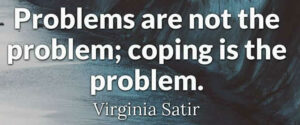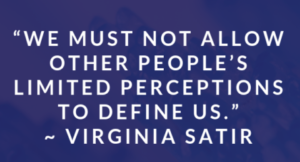by Geric Lebedoff, Ph.D.
Why am I writing an article on Virginia Satir over three decades after her death?
Because I believe that whenever therapists are interested in healing others and using whatever “modern” techniques in their practice it is useful to acknowledge the fact that Satir’s teachings offered a gold mine of principles that might be of interest to themselves and their clients.
It strikes me that Satir intuitively used processes that were later further developed by some of our more well-known colleagues: Aaron Beck, David Burns, Laurel Parnell, Peter Levine, Richard Schwartz, Eugene Gendlin, Pat Ogden, Dan Siegel, and many others.
Satir originally worked in and was known as a pioneer and expert in family therapy. But her process extends well beyond family therapy and is applicable to all kind of groups and individuals, too.
She defined herself as a healer and a teacher rather than a therapist. Indeed, I see her as a kind of Shaman, and what else is a shaman but a healer?
My goal in this article is to highlight what I believe was Satir’s amazing foresight in creating therapeutic concepts and designing tools that I am using in my practice to my great satisfaction and my clients. I trust this will encourage readers to further dig into the riches of Satir’s teachings.
En passant, allow me to pay a tribute to Sharon Loeschen. She currently heads the Virginia Satir Network and has written numerous books on Satir that are of outstanding value. I was lucky enough to be trained by Sharon to become a Satir coach. I thus became even further addicted to Satir‘s wisdom. I am grateful to Sharon for that (www.satirglobal.org).
Satir’s Basic Rules of Therapy
My first emphasis is on Satir’s statement that the problem is not the problem, coping is the problem. Hence her technique to increase her patients’ coping abilities to obtain astounding results. She always specifically directed her work to the patient and his relationship to himself and to others.
Further, she realized that to be efficient in therapy, there were three basic rules:
First: put emphasis on hope so that people enter therapy with a positive feeling.
Second: strengthen and enhance patients’ coping skills by teaching them new ways of viewing and handling situations. She wrote, “My hope is that my interview will result in a new window for each person to look through with the result of feeling better about himself and gaining the ability to do things more creatively” (Kramer, 1995). As usual, she was centering her intervention on a coping process and not on a problem-solving process.
Third: make people conscious that they always have the ability to make choices, that they have the resources to be well but that these resources are merely untapped. They then feel competent and able to cope. They then can be guided to understand the underlying dynamics that led to the pain or the problem.
I believe that when our clients suffer, their suffering exists because there is blocked energy. Energy that needs to be redirected slowly so that the patient can return to ‘the social engagement state’ so well described by Stephen W. Porges in his Polyvagal theory and so well developed by Peter Levine in his Somatic Experiencing technique.
In other words, you don’t eradicate symptoms just as you don’t eradicate memories, but you can and must develop health by re-installing equilibrium in the autonomic nervous system so that the client can again nicely co-regulate with the others. Here again Satir’s prescience is striking: She fully appreciated the fact that the problem in itself has no meaning independent of how the patient feels about it in his mind and in his body.
To look for the patient’s feelings is key in the healing process. The story is not so interesting. What is interesting is to listen to the voice that does not use words, following Rumi’s teaching and Peter Levine‘s thoughts (2010).
In the stead of asking the patient “tell me more”, Satir, as Peter Levine, asked, “Where do you notice that in your body? And what comes up when you pay attention to that?” At the outset we don’t need words; the narrative of the body suffices and is key because it cannot deceive, it comes from the unconscious. To a certain extent, by asking the right questions you apply a hypnotic technique. Indeed, as Milton Erickson used to say, “Hypnosis is a technique in which you don’t command your patients, you don’t tell them what to do, you create a situation in which their conscious interests slowly drift away and their unconscious interests come to the foreground (miltonericksondvds.com, “In the Room with M. H. Erickson”.)
Thus Satir’s reaction to someone who was getting angry was to acknowledge that state and then develop a safe climate by reminding the patient that being angry is a universal feeling with, per se, no negative connotation, but that at the same time it deprives us of the ability to see properly, in fact it is a feeling that precludes us from seeing.
And that conclusion can be accessed by the patient when he goes inward, in a kind of a trance and when he then notices that feeling and observes and explores its consequences.
In a family setting Satir invited therapists to check how the other members of the family handled their problems. Angry feelings are common, but their expression often makes the difference between a functional and a dysfunctional family.
The same holds true in any group of people, including of course at the office. What Satir was aiming at was to give patients the capacity of self- regulation that would permit them to take care of their difficult emotions and pave the way to a balance between autonomy and healthy social engagement.
Indeed, she listened carefully to the patient. She didn’t ask, “What is your problem?” but rather “What is your hope, what would you like to happen?” She always made sure patients felt safe and not defensive because defensiveness always leads to deafness.
Satir taught us how to rephrase and reframe the patient’s narrative. For example, people frequently use anger to keep their self-esteem intact. It is easier to state, “I am angry”, versus “I am hurt,” which is much hard and opens a place of vulnerability that people don’t easily want others to access.
Self-Worth
Another key that Satir taught involved the concept of self-worth. People who feel misunderstood often suffer from loss of self-worth, which in turn cuts down on their productivity and joy of living. Satir helped people to enhance their self-worth so they could develop a new consciousness about themselves and in turn develop their willingness to make all kinds of changes. And indeed, by doing so, things change as if by magic.
Satir never labeled people. She knew that anything could be a reaction and thus she simply described rather than labeled. She listened to people and showed them that they mattered so they could “feel felt” to use words coined by Eugene Gendlin (1978). This process enabled them to feel better. It is largely based on the principle that all human beings are a manifestation of positive self-energy and that this energy can transform people’s dysfunctional coping into high levels of self-care within the context of self-esteem. Here I offer a quote by Einstein: “Everything is energy that is all what is to be understood in life. Get aligned to the frequency of the reality that you want, and that reality will manifest itself. It cannot be otherwise. That is not philosophy. That is physics” (quotation credited to Albert Einstein but not to be found in “the Ultimate Quotation Einstein” Princeton Univ. Press. Could be a quote from Darryl Anka,1996 or Bashar according to a website called “lightascension.com”)
Self-worth suffers when we feel that we are too much of one thing and not enough of what we should be (according to the others’ view of course), thus denying our personality. We are comparing ourselves to something external and if it does not fit, we do not fit. We then feel compelled or are compelled by others to conform and obey thus crippling ourselves and our sense of self.
Satir tells us that what we need to do is to help people to understand who they are, what their strengths and talents are, and to help them identify their inner resources and define themselves accordingly. That led Satir to develop her growth model: we all have the internal resources needed to grow, to become our own choice-makers and able to feel who we are without being bound by the opinions of the others , in other words to connect with our own self-worth and the others without negate our own identity.
The higher the self-worth, the easier coping rightly with the problem at hand is possible. High self-worth will necessarily lead to change whenever change is needed.
Change: A Five Stage Process
Let’s end this article with a concept well comprehended by Satir: Change. Therapy is change. Education is change. Life is a flux in constant change. Change is so important and yet sometimes so difficult to go through.
Satir described a five-stage change process that I find profoundly useful.
Stage One: Status Quo
People find themselves living in the status quo. They are in a system where they can predict what will happen. This known predictability is familiarity and people love familiarity (even if it is a negative familiarity prediction). Satir reminded us that familiarity, even it was terrible, was stronger than comfort, and if comfort was missing a lot of work was required to go there.
In this place of status quo, there are a set of assumptions that lead to predictions one can rely on—if I do this, I will get that.
Nothing will happen unless people are overwhelmed by the negativity of the familiarity they are in and unless something happens to push them to take action, for instance an unbearable threat.
This creates of course stress, good stress because without it one would take no action. If people end up being in such a mess and realize they are isolated, they keep failing, they find it impossible to grow, to learn, then they might find the courage to go forward. They then take the first scary step to go to the unknown.
 Stage Two: The Unknown: Introduction of a New Foreign Element
Stage Two: The Unknown: Introduction of a New Foreign Element
As therapists I think it’s our job to explain to clients that going into the unknown is the most challenging thing they can think of—since childhood they were told that they should not go to the unknown. And that is a fully explainable Neanderthal kind of reaction! Our tribal ancestors knew that in order to survive they had to stay within the compound of the cave, a familiar safe place (even if they were beaten up by alpha males sometimes).
So, in stage two, there is the introduction of a foreign element, a compelling wish so great that one feels a change is needed.
Stage Three: Chaos
The old order cannot function anymore because there is now a new element. Here Satir reminded us of the importance of the therapist’s role because clients are particularly vulnerable and will be quick to shut down, close off, leave. She offered a parallel with a transplant: because it does not belong there, it can easily wither and die. At this point the client is in limbo, already far away from where he was but not close enough yet to be where he is going. It is only temporary but let’s face it, he is in an uncomfortable place where predictability does not exist anymore. When dealing with this transition point, I find that using Peter Levine’s Somatic Experiencing process is of value so that the feelings in the body shift into feelings of strength and a state of inner resources.
Satir was clear that nothing can change, nothing can happen without this chaotic period. Otherwise the old drums are going to play again. It is crucial for the client to be able to say to himself: God, what I am going through is normal. The idea is to realize that because of being in that limbo state, there is a kind of openness in which one can have a new kind of experimentation. Therapists need to support clients who are prone to say, “I want but I can’t”. Satir pushed clients and asked them to nonetheless have a look. She was so sure about the growth potential of any human being that she merely invited her clients to move on with her full support.
She asked, “What do you feel?” And if the client started to tremble, she took his hand. If the client said, “I want love”, she asked, “What does it feel to have these words come out?” She took the unspeakable and made it speakable with nurturing.
At this point in time, changes start to occur. Satir was using her power to help clients grow.
 Stage Four: Integration
Stage Four: Integration
“Neurons that fire together, wire together” (Hebb, 1949).
Satir asked her clients to practice what they learned. If they learned to say, “I want” (for the first time most likely), she asked, “What thing to you want to remember having learned today? Write it down, color it” (this will remind us of the drawing therapy techniques: Furth, 2002). By practicing enough, new neuronal pathways are created and finally one will reach a new place, a new status quo, thus reaching step five.
Stage Five: The New Status Quo
Here patients are in a place where they know it is possible to be in another place, where it is possible to believe that now I can say “I want” and “I am in a new place.”
With this change, other changes occur. For instance, anxiety. When patients first consider their decision to make a change, their anxiety levels are probably close to 95%. When they entered the chaos state, their anxiety probably dropped to around 50% and then when reaching into a new status quo, most like they are around 35%.
Again and again, Satir’s work teaches therapists how to help people move from sickness to health, from feelings of rejection to feelings of acceptance, and then to keep going with a new vitality, an enhanced self-worth and endless growth based on their life force.
References
Kramer, S. Z. (1995). Transforming the inner and outer family. New York: The Haword Press.
Levine, P. (2010). In an unspoken voice: How the body releases trauma and restores goodness. Berkeley, CA: North Atlantic Books.
Gendlin, E. (1978). Focusing. New York: Everest House. New York: Bantam reissue, 2007
Furth, G. M. (2002). The secret world of drawing: A Jungian approach to healing (2nd ed.). Toronto, Canada: Inner City Books.
Photo credits:
photo of Virginia Satir by w:User:William Meyer – User-made photograph, Public Domain, https://commons.wikimedia.org/w/index.php?curid=2795962
man entering forest: Photo by Kiwihug on Unsplash
energy: Photo by Hal Gatewood on Unsplash
neurons: Image by Gerd Altmann from Pixabay










